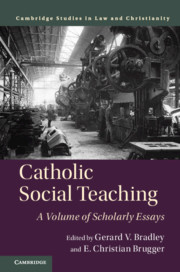45 results
15 - The Challenge Ahead
- from Part III - Law, Politics, and Economics
-
-
- Book:
- The Cambridge Companion to the First Amendment and Religious Liberty
- Published online:
- 17 December 2019
- Print publication:
- 09 January 2020, pp 428-456
-
- Chapter
- Export citation
Index of Ecclesiastical Texts
-
- Book:
- Catholic Social Teaching
- Published online:
- 12 July 2019
- Print publication:
- 01 August 2019, pp 622-624
-
- Chapter
- Export citation
Contributors
-
- Book:
- Catholic Social Teaching
- Published online:
- 12 July 2019
- Print publication:
- 01 August 2019, pp xiv-xv
-
- Chapter
- Export citation
Bibliography
-
- Book:
- Catholic Social Teaching
- Published online:
- 12 July 2019
- Print publication:
- 01 August 2019, pp 585-608
-
- Chapter
- Export citation
Contents
-
- Book:
- Catholic Social Teaching
- Published online:
- 12 July 2019
- Print publication:
- 01 August 2019, pp xi-xiii
-
- Chapter
- Export citation
Part IV - Evaluative and Critical Reflections
-
- Book:
- Catholic Social Teaching
- Published online:
- 12 July 2019
- Print publication:
- 01 August 2019, pp 507-584
-
- Chapter
- Export citation
Dedication
-
- Book:
- Catholic Social Teaching
- Published online:
- 12 July 2019
- Print publication:
- 01 August 2019, pp ix-x
-
- Chapter
- Export citation
Introduction - Contingency, Continuity, Development, and Change in Modern Catholic Social Teaching
-
-
- Book:
- Catholic Social Teaching
- Published online:
- 12 July 2019
- Print publication:
- 01 August 2019, pp 1-8
-
- Chapter
- Export citation
Copyright page
-
- Book:
- Catholic Social Teaching
- Published online:
- 12 July 2019
- Print publication:
- 01 August 2019, pp viii-viii
-
- Chapter
- Export citation
Acknowledgments
-
- Book:
- Catholic Social Teaching
- Published online:
- 12 July 2019
- Print publication:
- 01 August 2019, pp xvi-xvii
-
- Chapter
- Export citation
Part II - Leo XIII to Francis: The Documentary Tradition
-
- Book:
- Catholic Social Teaching
- Published online:
- 12 July 2019
- Print publication:
- 01 August 2019, pp 67-232
-
- Chapter
- Export citation
22 - How Bishops Should Teach Catholic Social Doctrine
- from Part IV - Evaluative and Critical Reflections
-
-
- Book:
- Catholic Social Teaching
- Published online:
- 12 July 2019
- Print publication:
- 01 August 2019, pp 528-547
-
- Chapter
- Export citation
Part I - Historical Background
-
- Book:
- Catholic Social Teaching
- Published online:
- 12 July 2019
- Print publication:
- 01 August 2019, pp 9-66
-
- Chapter
- Export citation
Index of Names and Subjects
-
- Book:
- Catholic Social Teaching
- Published online:
- 12 July 2019
- Print publication:
- 01 August 2019, pp 609-621
-
- Chapter
- Export citation
Abbreviations
-
- Book:
- Catholic Social Teaching
- Published online:
- 12 July 2019
- Print publication:
- 01 August 2019, pp xviii-xxii
-
- Chapter
- Export citation
Frontispiece
-
- Book:
- Catholic Social Teaching
- Published online:
- 12 July 2019
- Print publication:
- 01 August 2019, pp vi-vi
-
- Chapter
- Export citation
Part III - Themes in Catholic Social Teaching
-
- Book:
- Catholic Social Teaching
- Published online:
- 12 July 2019
- Print publication:
- 01 August 2019, pp 233-506
-
- Chapter
- Export citation

Catholic Social Teaching
- A Volume of Scholarly Essays
-
- Published online:
- 12 July 2019
- Print publication:
- 01 August 2019
17 - The Jurisprudence of Robert P. George
-
-
- Book:
- Great Christian Jurists in American History
- Published online:
- 24 June 2019
- Print publication:
- 04 July 2019, pp 300-318
-
- Chapter
- Export citation
SMITH, “NEUTRALITY OF REASONS,” AND THE SEARCH FOR ANIMATING PRINCIPLES - The Distinctiveness of Religion in American Law: Rethinking Religion Clause Jurisprudence. By Kathleen A. Brady. Cambridge: Cambridge University Press, 2015. Pp. 354. $39.99 (paper). ISBN: 978-1107016507.
-
- Journal:
- Journal of Law and Religion / Volume 32 / Issue 3 / November 2017
- Published online by Cambridge University Press:
- 12 April 2018, pp. 496-498
- Print publication:
- November 2017
-
- Article
- Export citation



